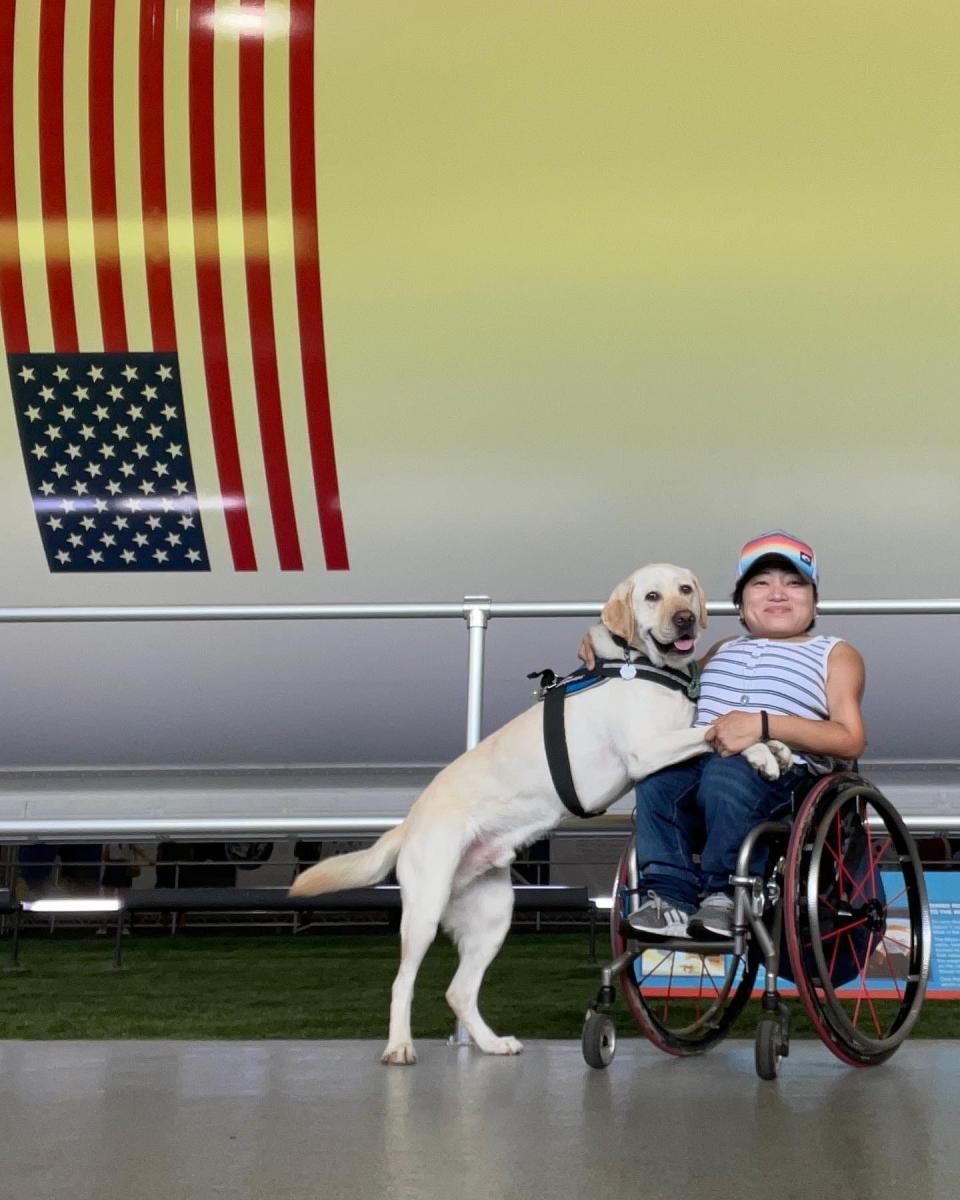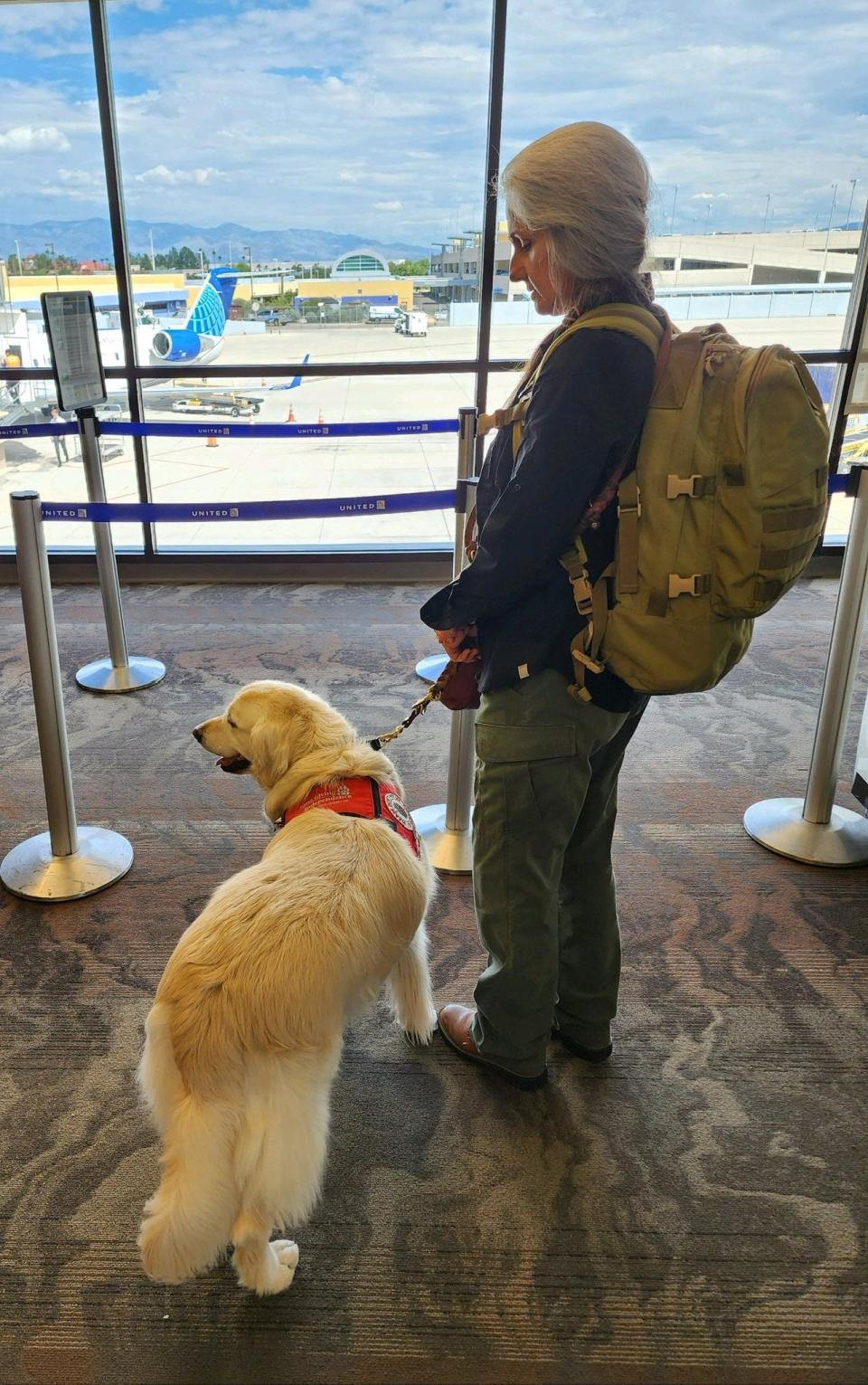Service dogs are allowed on planes, but there are some requirements to get them there
Mia Ives-Rublee said that when she travels with her 6-year-old Labrador/Golden Retriever mix, Zini, she’s often asked about him in more detail by airline and airport employees, and sometimes runs into other issues as well.
“Even with the obvious, having a disability, I still get questioned about him and whether he is an actual service dog,” she said. “Sometimes I’ll deal with a TSA person who is afraid of dogs, which I totally understand, but sometimes their reactions get a little old. … I understand that there are people who are afraid of dogs but just jumping out of the way, etc., it doesn’t provide for a very friendly atmosphere.”
Regulations around traveling with service animals have changed in the past few years, so it’s important to be up to date.
Here’s what experts say service animal handlers and fellow travelers should know:

Cruising Altitude: Progress for disabled travelers is not coming fast enough
What qualifies as a service animal?
According to the Department of Transportation, only dogs count as service animals – sorry to the emotional support peacocks and service miniature horses out there.
“The biggest thing is that service animals, the definition of service animals in the eyes of the Department of Transportation is that service animals are service dogs, that term is synonymous basically,” Noah Holtgraves, a data and tips writer for Trips to Discover told USA TODAY.
What are the requirements for a service animal?
DOT regulations state that dogs of any size or breed can qualify as service animals, so long as they are “individually trained to do work or perform tasks for the benefit of a qualified individual with a disability, including a physical, sensory, psychiatric, intellectual, or other mental disability.”
Beyond that, service animal handlers can only ever be required to submit two forms to the airlines, and legally, airline employees are restricted in what they can ask about a service animal.
The forms include:
An attestation about the animal’s health, behavior and training.
An attestation that the animal is able to wait up to eight hours to relieve itself.
“The DOT has made it pretty explicitly clear that no other documentation is allowed outside those two forms,” Holtgraves said, and airlines can require the forms to be submitted up to 48 hours in advance.
But travelers with experience flying with service dogs told USA TODAY things don’t always go as smoothly as the regulations might suggest.
Tell us your story: Mobility device lost or damaged by an airline? USA TODAY wants to hear about it.
Joey Ramp-Adams said she travels frequently with her 10-year-old service dog Sampson, a golden retriever, and said issues are rare but extremely frustrating when they do happen.
“For the most part, it’s relatively smooth and accommodating but not always,” she said, adding that problems seem more likely to occur at the airport rather than on the plane.
“I have had a lot of issues with checking in,” she said. “Education is a big, big thing and making sure that people are very aware of what is allowed and not allowed and how they go about conducting check-ins.”
Although service dogs are required to be trained, there’s no national service animal registry or any formal licensing for training facilities.
“There’s no certification at all that’s required to fly,” Holtgraves said. “If you train your own service dog you can list yourself as the trainer.”

Can service animals ever be denied boarding?
Airlines are required to transport service animals free of charge, but the DOT outlines specific conditions under which they can be denied boarding. Those include:
If the dog is too large or heavy to be accommodated in the cabin.
If it poses a direct threat to the health or safety of other passengers.
If it causes significant disruption at the gate or onboard the aircraft.
If it does not comply with the health and safety requirements of an international destination.
Holtgraves added that airlines may require handlers to purchase a seat for some large service dogs.
Not so fast: Why you should think twice before booking flights with a tight connection
How should other travelers act around service animals?
Ives-Rublee and Ramp-Adams both said that as frustrating as it can be, other travelers should do their best to not try to get a service animal’s attention.
“I know Sampson is gorgeous and fluffy and cute, (but) please don’t interact with a service animal,” Ramp-Adams said. “That moment of distraction can cause an accident or can cause the handler to get injured.”
Ives-Rublee said service animals are pretty much always on the clock when they’re out in public.
“Even if the dog doesn’t look like they’re quote-unquote working, they are working, and your interactions could create distractions,” she said. “Your interactions with them, whether it is petting, or talking to them, or even saying their name, it creates distractions for the dogs, which can create dangerous situations for the handlers.”
Both women also said it’s important to ask the handlers before petting a service animal and not to get offended if you’re told no.
“There’s many times I have to put my hand down and block someone who’s trying to do what I call a drive-by petting,” Ramp-Adams said.
Fan favorites: Southwest, Delta and JetBlue win top marks for customer satisfaction in J.D. Power survey
Advice for new service animal handlers
Ives-Rublee said it’s especially important to plan ahead if you’re not used to traveling with a service animal.
“I don’t have kids, but my guess is it’s very similar to traveling with a small child,” she said. “It’s definitely packing for another individual.”
In addition to making sure your dog has all the food, water and accessories it might need for a trip, Ives-Rublee and Ramp-Adams said it’s a good idea to familiarize yourself with the requirements including the DOT forms, to notify the airlines that you’ll be traveling with a service animal in advance, and to keep the dog’s paperwork with you, even though presenting it should technically never be required.
Ramp-Adams added that traveling can be stressful for a service dog, so you should make sure they’re ready for a long stretch in a potentially uncomfortable environment.
“Being on a plane is one of the most taxing and stressful environments, I believe, for a dog to be in,” she said. “That can’t be replicated or practiced unless you’re working with an organization that actually does that as part of its training … (make) sure your dog is ready for that type of stress.”
Zach Wichter is a travel reporter for USA TODAY based in New York. You can reach him at zwichter@usatoday.com.
This article originally appeared on USA TODAY: What to expect when traveling with a service dog this summer

